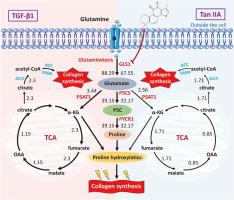当前位置:
X-MOL 学术
›
J. Adv. Res.
›
论文详情
Our official English website, www.x-mol.net, welcomes your feedback! (Note: you will need to create a separate account there.)
Tanshinone IIA alleviates pulmonary fibrosis by modulating glutamine metabolic reprogramming based on [U-13C5]-glutamine metabolic flux analysis
Journal of Advanced Research ( IF 11.4 ) Pub Date : 2024-05-01 , DOI: 10.1016/j.jare.2024.04.029 Baixi Shan , Congying Guo , Haoyan Zhou , Jun Chen
Journal of Advanced Research ( IF 11.4 ) Pub Date : 2024-05-01 , DOI: 10.1016/j.jare.2024.04.029 Baixi Shan , Congying Guo , Haoyan Zhou , Jun Chen

|
Glutamine metabolic reprogramming, mediated by glutaminase (GLS), is an important signal during pulmonary fibrosis (PF) progression. Tanshinone IIA (Tan IIA) is a naturally lipophilic diterpene with antioxidant and antifibrotic properties. However, the potential mechanisms of Tan IIA for regulating glutamine metabolic reprogramming are not yet clear. This study aimed was to evaluate the role of Tan IIA in intervening in glutamine metabolic reprogramming to exert anti-PF and to explore the potential new mechanisms of metabolic regulation. Fibrotic characteristics was detected via immunofluorescence and western blotting analysis. Cell proliferation was examined with EdU Assay. Cell metabolites were labeled by using stable isotope [U-C]-glutamine. By utilizing 100% C glutamine tracers and employing network analysis to investigate the activation of metabolic pathways in fibroblasts, as well as evaluating the impact of Tan IIA on these pathways, we accurately quantified the absolute flux of glutaminolysis, proline synthesis, and the TCA cycle pathway using isotopomer network compartmental analysis (INCA), a user-friendly software tool for C metabolic flux analysis (C-MFA). Molecular docking was used for identifying the binding of Tan IIA with target protein. Tan IIA ameliorate TGF-β1-induced myofibroblast proliferation, reduce collagen I and III and α-SMA protein expression in MRC-5 and NIH-3T3 cells. Furthermore, Tan IIA regulate mitochondrial energy metabolism by modulating TGF-β1-stimulated glutamine metabolic reprogramming in NIH-3T3 cells and inhibiting GLS1 expression, which reduced the metabolic flux of glutamine into mitochondria in myofibroblasts, and also targeted inhibited the expression of Δ1-pyrroline-5-carboxylate synthase (P5CS), P5C reductase 1 (PYCR1), and phosphoserine aminotransferase 1 (PSAT1), and reduced proline hydroxylation and blocked the collagen synthesis pathway. Tan IIA reverses glutamine metabolic reprogramming, reduces mitochondrial energy expenditure, and inhibits collagen matrix synthesis by modulating potential targets in glutamine metabolism. This novel perspective sheds light on the essential role of glutamine metabolic reprogramming in PF.
中文翻译:

基于 [U-13C5]-谷氨酰胺代谢流分析,丹参酮 IIA 通过调节谷氨酰胺代谢重编程减轻肺纤维化
由谷氨酰胺酶(GLS)介导的谷氨酰胺代谢重编程是肺纤维化(PF)进展过程中的重要信号。丹参酮 IIA (Tan IIA) 是一种天然亲脂性二萜,具有抗氧化和抗纤维化特性。然而,Tan IIA 调节谷氨酰胺代谢重编程的潜在机制尚不清楚。本研究旨在评估Tan IIA在干预谷氨酰胺代谢重编程以发挥抗PF作用中的作用,并探索潜在的代谢调节新机制。通过免疫荧光和蛋白质印迹分析检测纤维化特征。用 EdU Assay 检查细胞增殖。使用稳定同位素[U-C]-谷氨酰胺标记细胞代谢物。通过利用 100% C 谷氨酰胺示踪剂并采用网络分析来研究成纤维细胞中代谢途径的激活,以及评估 Tan IIA 对这些途径的影响,我们准确地量化了谷氨酰胺分解、脯氨酸合成和 TCA 循环的绝对通量使用同位素异构体网络区室分析 (INCA) 分析途径,这是一种用户友好的 C 代谢通量分析 (C-MFA) 软件工具。分子对接用于鉴定 Tan IIA 与靶蛋白的结合。 Tan IIA 可改善 TGF-β1 诱导的肌成纤维细胞增殖,降低 MRC-5 和 NIH-3T3 细胞中胶原蛋白 I 和 III 以及 α-SMA 蛋白的表达。 此外,Tan IIA通过调节NIH-3T3细胞中TGF-β1刺激的谷氨酰胺代谢重编程和抑制GLS1表达来调节线粒体能量代谢,从而减少肌成纤维细胞中谷氨酰胺进入线粒体的代谢通量,并靶向抑制Δ1-吡咯啉的表达-5-羧酸合酶 (P5CS)、P5C 还原酶 1 (PYCR1) 和磷酸丝氨酸转氨酶 1 (PSAT1),并减少脯氨酸羟基化并阻断胶原蛋白合成途径。 Tan IIA 可逆转谷氨酰胺代谢重编程,减少线粒体能量消耗,并通过调节谷氨酰胺代谢中的潜在目标来抑制胶原蛋白基质合成。这一新颖的视角揭示了谷氨酰胺代谢重编程在肺纤维化中的重要作用。
更新日期:2024-05-01
中文翻译:

基于 [U-13C5]-谷氨酰胺代谢流分析,丹参酮 IIA 通过调节谷氨酰胺代谢重编程减轻肺纤维化
由谷氨酰胺酶(GLS)介导的谷氨酰胺代谢重编程是肺纤维化(PF)进展过程中的重要信号。丹参酮 IIA (Tan IIA) 是一种天然亲脂性二萜,具有抗氧化和抗纤维化特性。然而,Tan IIA 调节谷氨酰胺代谢重编程的潜在机制尚不清楚。本研究旨在评估Tan IIA在干预谷氨酰胺代谢重编程以发挥抗PF作用中的作用,并探索潜在的代谢调节新机制。通过免疫荧光和蛋白质印迹分析检测纤维化特征。用 EdU Assay 检查细胞增殖。使用稳定同位素[U-C]-谷氨酰胺标记细胞代谢物。通过利用 100% C 谷氨酰胺示踪剂并采用网络分析来研究成纤维细胞中代谢途径的激活,以及评估 Tan IIA 对这些途径的影响,我们准确地量化了谷氨酰胺分解、脯氨酸合成和 TCA 循环的绝对通量使用同位素异构体网络区室分析 (INCA) 分析途径,这是一种用户友好的 C 代谢通量分析 (C-MFA) 软件工具。分子对接用于鉴定 Tan IIA 与靶蛋白的结合。 Tan IIA 可改善 TGF-β1 诱导的肌成纤维细胞增殖,降低 MRC-5 和 NIH-3T3 细胞中胶原蛋白 I 和 III 以及 α-SMA 蛋白的表达。 此外,Tan IIA通过调节NIH-3T3细胞中TGF-β1刺激的谷氨酰胺代谢重编程和抑制GLS1表达来调节线粒体能量代谢,从而减少肌成纤维细胞中谷氨酰胺进入线粒体的代谢通量,并靶向抑制Δ1-吡咯啉的表达-5-羧酸合酶 (P5CS)、P5C 还原酶 1 (PYCR1) 和磷酸丝氨酸转氨酶 1 (PSAT1),并减少脯氨酸羟基化并阻断胶原蛋白合成途径。 Tan IIA 可逆转谷氨酰胺代谢重编程,减少线粒体能量消耗,并通过调节谷氨酰胺代谢中的潜在目标来抑制胶原蛋白基质合成。这一新颖的视角揭示了谷氨酰胺代谢重编程在肺纤维化中的重要作用。











































 京公网安备 11010802027423号
京公网安备 11010802027423号